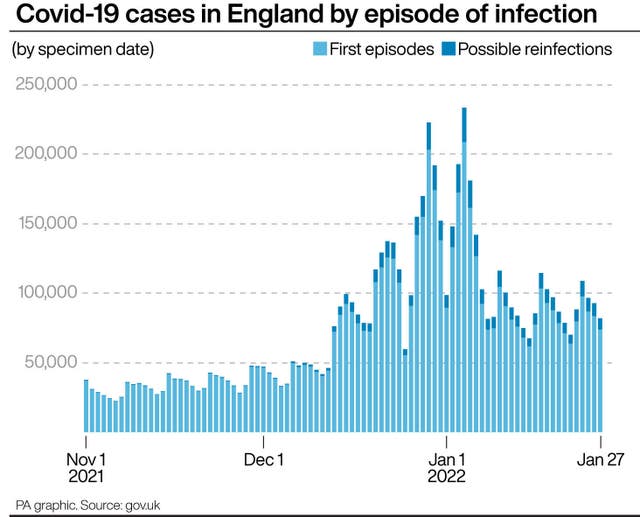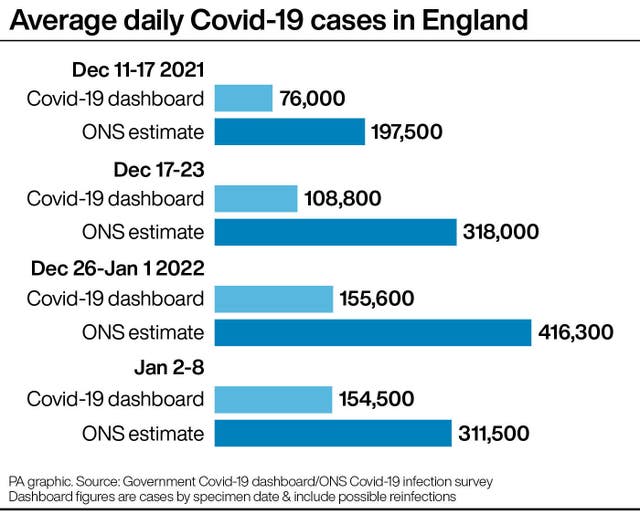Daily reported cases of Covid-19 now include possible reinfections
Reinfections currently represent around 10% of infection episodes per day.

Covid-19 reinfections have been included in the Government’s daily coronavirus figures for the first time.
The number of cases reported in the UK now includes possible reinfections in England and Northern Ireland, with data for Scotland and Wales to be added in the near future.
A reinfection is defined as someone who tests positive for Covid-19 more than 90 days after a previous positive result.
Any positive tests within 90 days of a previous one are counted as part of the same “infection episode”.

Until now, the daily figures for cases included only people who had reported themselves as testing positive for the virus for the first time.
The change has been applied to previous data on the dashboard showing the number of cases by specimen date – when a person tested positive – but not historic data for cases reported each day.
The cumulative number of UK cases since the pandemic began has been adjusted to incorporate all possible reinfections, however.
It has jumped from 16.5 million as of January 30 to 17.3 million as of January 31.
Of the 14.8 million infection episodes in England since the start of the pandemic, some 588,114 (4.0%) are likely reinfections.
Reinfection rates in England averaged around 1.4% of cases up to November 16 2021, after which there was a spike in infection episodes following the arrival of the Omicron variant of the virus.
Reinfections currently represent around 10% of episodes per day – for example, of the 108,882 cases in England with a specimen date of January 24, 11,167 (10.3%) have been categorised as likely reinfections.
Estimates of reinfections have been available since last year in the weekly surveillance report from the UK Health Security Agency (HSA).

“As the pandemic continues and more variants emerge, it is more likely that people will be reinfected with Covid-19,” the HSA said.
“UK public health agencies are now updating surveillance data to count infection episodes, including reinfection episodes.
“It is right that our daily reporting processes reflect how the virus has changed.”
While the number of cases announced each day will now be slightly higher than previously, it will still be under-reporting the actual number of people getting infected with the virus.
This is because the dashboard data is based only on people who have reported themselves as testing positive for the virus – and is therefore affected by how many people are deciding to take a test, how many are choosing to report their results, and how many are taking a test because they know they have symptoms.
The most reliable estimate of the number of cases of coronavirus per day across the country is published as part of the weekly infection survey by the Office for National Statistics (ONS).
For example, an average of 154,500 cases by specimen date were recorded each day in England from January 2 to 8 according to the Government dashboard, including possible reinfections.
But the true number was likely to be nearer 311,500 a day, according to the ONS.
Their estimates are based on analysis of nose and throat swabs taken from a representative sample of more than 150,000 people in private households.
The same people are sampled every week, regardless of whether they know they have Covid-19 or have reported a positive result.
Paul Hunter, professor of health protection at the University of East Anglia, said the growing number of reinfections since the emergence of the Omicron variant meant that not reporting them in the official figures was “no longer tenable”.
“Although the proportion of all infections that are due to reinfection is still relatively small, this proportion is increasing, and we can expect this to grow,” he said.
“So far, the addition of reinfections have not much changed estimates of the speed of increase or decrease in the epidemic over recent weeks. Fortunately, reinfections are usually, though not always, less severe than primary infections and consequently we can expect the severity of Covid to decrease further as more and more of the daily infections are reinfections.”
Rowland Kao, professor of veterinary epidemiology and data science at the University of Edinburgh, said that high numbers of reinfections are likely to reflect the “sheer number” of people already infected, combined with the fact that “as immunity wanes, the likelihood is that protection is also waning”.
He added: “Having an estimate of the rate of reinfection will help to determine how quickly immunity is waning across the country and therefore, crucially, when further boosters may need to be considered.
“What is important to remember is that, while the total number of infections recorded will change, the numbers we should be most concerned about are the numbers of individuals with severe consequences and the number of deaths – so long as these continue to go down, it will be broadly good news.”





